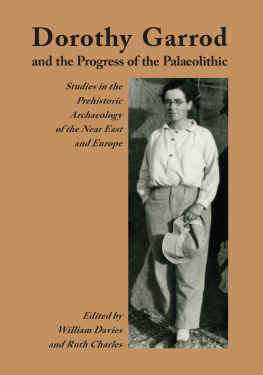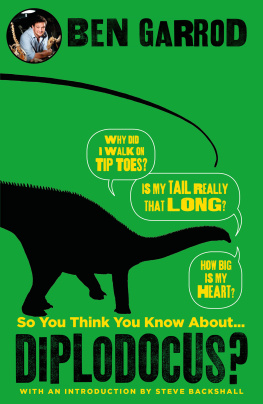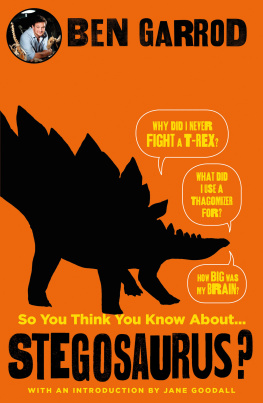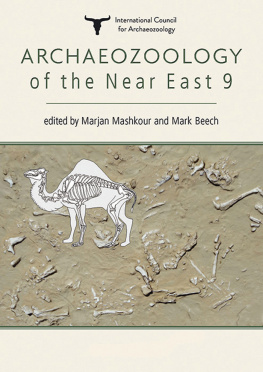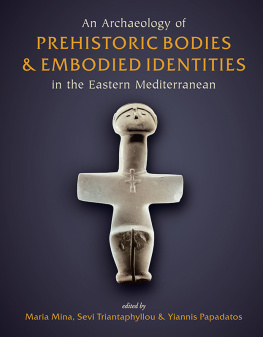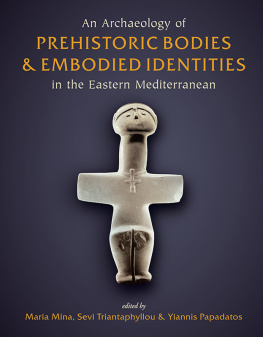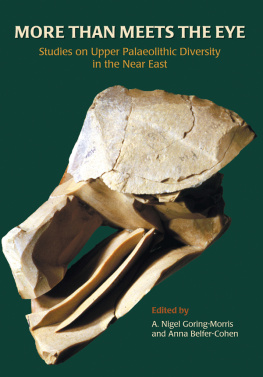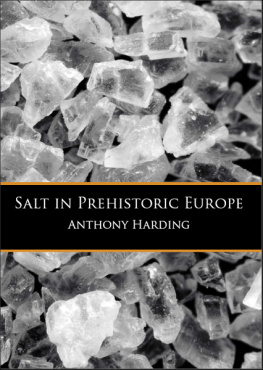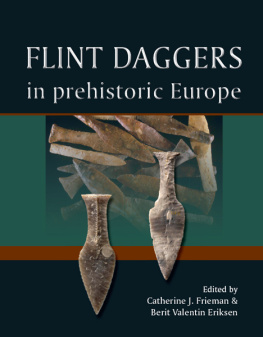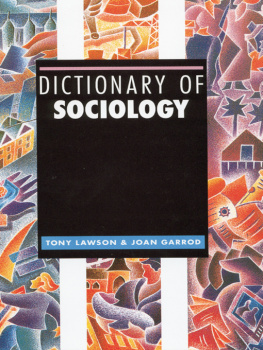
Dorothy Garrod with a brown bear cub in Anatolia in Summer 1938. (Photograph courtesy of the Pitt Rivers Museum, Oxford)
Dorothy Garrod and the Progress of the Palaeolithic
Studies in the Prehistoric Archaeology of the Near East and Europe
Edited by
William Davies and Ruth Charles
Oxbow Books
1999
First published in the United Kingdom in 1999. Reprinted in 2017 by
OXBOW BOOKS
The Old Music Hall, 106108 Cowley Road, Oxford OX4 1JE
and in the United States by
OXBOW BOOKS
1950 Lawrence Road, Havertown, PA 19083
Oxbow Books and the individual contributors 1999
Paperback Edition: ISBN 978-1-78570-519-9
Digital Edition: ISBN 978-1-78570-520-5
Mobi Edition: ISBN 978-1-78570-521-2
A CIP record for this book is available from the British Library
All rights reserved. No part of this book may be reproduced or transmitted in any form or by any means, electronic or mechanical including photocopying, recording or by any information storage and retrieval system, without permission from the publisher in writing.
For a complete list of Oxbow titles, please contact:
| UNITED KINGDOM | UNITED STATES OF AMERICA |
| Oxbow Books | Oxbow Books |
| Telephone (01865) 241249, Fax (01865) 794449 | Telephone (800) 791-9354, Fax (610) 853-9146 |
| Email: | Email: |
| www.oxbowbooks.com | www.casemateacademic.com/oxbow |
Oxbow Books is part of the Casemate Group
Front cover: Dorothy Garrod at Mount Carmel in 1931.
List of Contributors
P. G. Bahn 428 Anlaby Road, Hull, HU3 6QP
R. N. E. Barton Department of Anthropology, Oxford Brookes University, Headington, Oxford, OX3 OBP
O. Bar-Yosef Department of Anthropology, Peabody Museum, Harvard University, Cambridge, MA 02138, U.S.A.
A. Belfer-Cohen Institute of Archaeology, The Hebrew University of Jerusalem, Mount Scopus, Jerusalem 91905, Israel
B. Boyd Department of Archaeology, University of Wales Lampeter, Ceredigion, SA48 7ED
R. Charles Department of Archaeology, University of Newcastle upon Tyne, Newcastle upon Tyne, NE1 7RU
L. Copeland Chteau de Marouatte, Grand Brassac, 24350 Tocane-St. Apr, France
A. P. Currant Department of Palaeontology, Natural History Museum, Cromwell Road, London, SW7 5BD
S. W. G. Davies Dorothy Garrod Laboratory, McDonald Institute for Archaeological Research, Downing Street, Cambridge, CB2 3ER
J. C. Finlayson The Gibraltar Museum, 1820 Bomb House Lane, Gibraltar
P. Goldberg Department of Archaeology, Boston University, 675 Commonwealth Ave, Boston, MA 02215, USA
R. Jacobi Dept. of Palaeontology, Natural History Museum, London, SW7 5BD
J. K. Kozowski Institute of Archaeology, Jagellonian University, ul. Golebia 11, 31007 Krakw, Poland
S. A. Laukhin Institute of Geography, Russian Academy of Sciences, Moscow 109017, Russia
R. Macphail Institute of Archaeology, University College London, 3134 Gordon Square, London, WC1H OPY
D. I. Olszewski Department of Anthropology, Bishop Museum, 1525 Bernice Street, Honolulu, HI 96817, USA
P. B. Pettitt Research Laboratory for Archaeology and the History of Art, University of Oxford, 6 Keble Road, Oxford, OX1 3QJ; Keble College, Oxford, OX1 3QJ
S. J. Plunkett Keeper of Archaeology, Ipswich Borough Museum, High Street, Ipswich, IP1 3QH
A. C. Renfrew Director, The McDonald Institute for Archaeological Research, Downing Street, Cambridge, CB2 3ER
A. J. Roberts Department of Antiquities, Ashmolean Museum, University of Oxford, Beaumont Street, Oxford, OX1 2PH
A. Ronen Zinman Institute of Archaeology, University of Haifa, Haifa 31905, Israel
C. B. Stringer Human Origins Group, Department of Palaeontology, Natural History Museum, Cromwell Road, London, SW7 5BD
S. Swainston SCARAB Research Centre, University of Wales College, Newport, Caerleon Campus, P.O. Box 179, Newport, NP6 1YG
A. Tsatskin Zinman Institute of Archaeology, University of Haifa, Haifa 31905, Israel
F. R. Valla Ethnologie Prhistorique, EP.1730 Archologies CNRS, 21 alle de luniversit, F-92023 NANTERRE cedex, France
G. A. Wahida 91 Glebe Road, Cambridge, CB1 4TE
Foreword
Dorothy Garrods work has a continuing relevance today, which outlives that of many of her contemporaries. It is remarkable, thirty years after her death (and well beyond a century after her birth), that a volume of studies should be dedicated to her memory and to the issues in prehistory which she raised. On reflection it is even more remarkable that her contributions have not been more widely recognised, and that this is the first such volume to be published.
That such a volume did not come about sooner is due in part to her reluctance to make sweepingly programmatic pronouncements, and in part due to her caution as a synthesiser. She wrote no broad surveys of the kind undertaken by her exact contemporary Gordon Childe, and so far there are no published biographies devoted to her life and work (where Childe has been the subject of at least three). She was of course primarily an excavator, and it is in the excavation reports that her best work is to be found.
That this volume comes about now is a remarkable tribute to her unerring sense of problem. She illuminated, indeed in some cases she initiated, avenues of research which seem even more clearly today than thirty years ago to address some of the central issues of prehistoric archaeology. Her first and highly successful excavation revealed fragments of Neanderthal fossils in Gibraltar. In moving to Western Asia, to Kurdistan, she worked on both the Mousterian and the Upper Palaeolithic (Zarzian). Then with the wonderful series of hominid remains from Mount Carmel she effectively initiated the study in Palestine of that remarkable transition to our own species Homo sapiens sapiens for which the Levant turns out to be a key area. There can be no more absorbing question for archaeology than the origins of our own species, and with her excavations there she blazed a trail which, as the papers in the volume show, is increasingly seen as of great relevance.
If the emergence and dispersal of our own species represents one of the most significant transitions in human history, the shift from hunter-gathering to food production is certainly another. Here her work on what, following Garrod, is now called the Natufian culture again forms the indispensable basis for the understanding of the first farming cultures which followed, as documented so clearly a few years later at Jericho by another redoubtable fieldworker, Dame Kathleen Kenyon.
This book begins with a sequence of papers focussing upon a theme rather closer to home. They take as their starting point her first work The Upper Palaeolithic Age in Britain, published in 1926 when she was only 34. This is a study which her future successor as Disney Professor, Grahame Clark, himself used as a point of departure for his own doctoral dissertation, The Mesolithic Age in Britain, published by Cambridge University Press just six years later. As we see here the hunter-gatherer period in Britain is once again a lively field of research.
Perhaps the most impressive feature of these papers, as they relate to Dorothy Garrod, is that they address directly the problems which interested her, and yet at the same time situate themselves in the mainstream of current research. Whether the focus is upon the Upper Palaeolithic of Britain, upon prehistoric Bulgaria or on the early Levant, it is refreshing to see that so many of the central archaeological issues of today can be traced back to the work of Dorothy Garrod half a century and more ago and to the pioneering studies which she undertook to further our understanding of the early prehistory of Europe and Western Asia.

